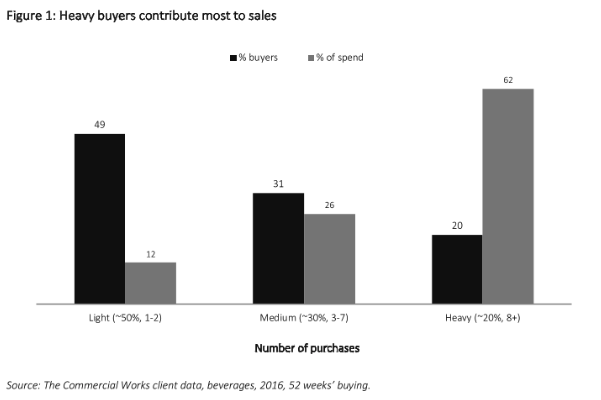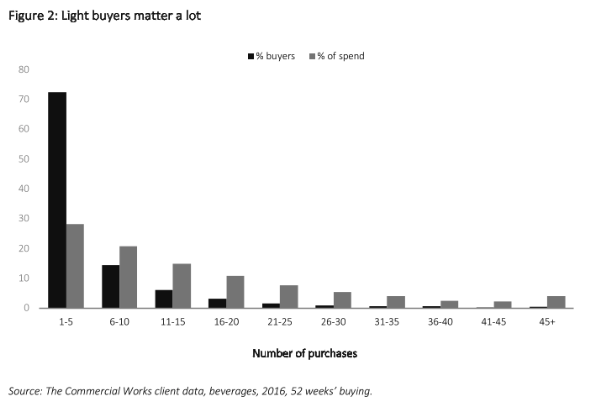Placement vs Messaging: Impact on marketing effectiveness


Around in-store marketing, there is a constant debate about which is more important: Where your ad goes in the store or what the ad says? Many argue that the message is unimportant and that you simply need to remind shoppers that your brand exists at the point of purchase. Meanwhile, others argue that the messaging must compel the shopper to choose your brand over another. So, should you focus on ad placement or the marketing message?
Your marketing message is equally as important as the placement. While the advert needs to be placed near your product and, ideally, the product category, there is little brand loyalty within many product categories. Therefore, the marketing message is equally important to increase revenues as the placement. However, the right message in a poor position will result in no one seeing it.
I reviewed the work of Mark Ritson, Ian Scott Wiemer Snijders, and Charles Graham. And their findings are quite counterintuitive to most marketing. For the purposes of this discussion, I’ll mostly be talking about brand activations within retail stores or grocery stores. However, there is a lot to unpack for retailers too.
Despite the noise around e-commerce and its growth, the NRF annual State of Retail in 2022 report found that 80% of all purchases still happen in stores. Additionally, Forbes identified that in-store shopping rose by 44% from 2021 to 2022. Meanwhile, Ecommerce’s share of the retail market peaked in April 2020 at 19% but returned to 15% when shops re-opened – still above pre-pandemic levels, but hardly the “death of retail” the media claimed.
In addition, POPAI’s Shopper Engagement Survey found that up to 82% of shoppers make purchase decisions in-store.
Whichever way you slice it, physical stores present the biggest market and the best opportunity to sway customers to choose your product.
Therefore, it should be no surprise that retailers and brands invest big in the channel. Print advertising and in-store displays is big business. We worked with a supermarket chain that spent £60 million/year on in-store marketing (and saved them 1.7m/year), while for others, it’s their biggest marketing expense!
And with so much being spent, it’s important that a brand’s in-store advertising is effective. Given the challenges with measuring the Return on Investment for in-store campaigns, it’s difficult to get a definitive answer, but it’s important to try.
Wherever you go, there’s an ongoing discussion about marketing communication channels. Should I use Google Ads or LinkedIn? Should I use paid advertising or trade shows? As marketers, we see these debates all the time.
However, promoting in-store isn’t an option for retailers, grocers, or brands; it’s necessary. You must have some form of in-store marketing to promote your product. It could be as simple as deciding where it goes on the shelf, as prominent as a manned tasting experience, or somewhere in the middle like an end-cap. But, if you sell through physical stores, you’re placing your product in front of people who can purchase it.
Unsurprisingly, simply promoting your product in the right place will boost sales. And this is where the debate begins. Many marketers argue the message is equally, if not more important. Ian Scott, a Rethink Retail Top 100 influencer, regularly shares his experiences in retail stores via LinkedIn. Beyond highlighting great experiences, he critiques marketing in-store marketing and offers insights into how it could be improved.
He recently shared the below example of a prominent promotion for Ariel’s new, more sustainable product offering.
It takes up a significant placement and grabs attention. But he argues that the messaging is uninspiring and a little confusing.
As Ian states in his post: ” ‘brrrilliant cleaning, even in a cold wash’ lacked any tangible benefits, despite having an A1 sized panel to communicate. Surely the benefits of cleaning in a cold wash could have been associated with the scarily high cost of services and the general cost of living right now? This was further challenged by product on the shelf below obscuring the bottom line of text.”
We’ve all heard the marketing mantra “sell the benefits, not the features, ” yet this promotion highlights the features.
Some will argue that the low stock levels demonstrate the message doesn’t matter. People still purchase it. The problem with that argument is that maybe the people that picked it up here would have purchased it anyway. We don’t have the data to know if it created a sales uplift or simply cannibalised its own sales.
Let’s explore each side of this argument in more detail.
The case for ad placement is fairly clear. You need to place your advertising where your target audience will see it. While this could differ depending on the category, there are generally 3 places brands will promote their products in a retail store:
There are many more that we’ve explored exhaustively in our article about the pros and cons of types of retail displays if you’d like to learn more.
Ultimately, your placement will depend on your product, the aims of your campaign, category behaviours, and your budget. However, every option will likely boost sales and be effective as they give your brand a more prominent placement.
This isn’t particularly revolutionary, but it’s good to confirm. However, there is a lot of evidence supporting the message being important.
To investigate why messaging is critical and not just an afterthought, we must first consider buyer behaviour.
Chapter 1 of the popular marketing book, Eat Your Greens explores the relationship between heavy and light category buyers.
Wimer Snijder and Charles Graham (The Commercial Works) studied data from 1 year of buying behaviour in the non-alcoholic beverages category to illustrate what a typical customer base looks like for a popular brand. About 1.5m people bought this brand over the course of a year and at varying frequencies.
The chart below details their findings. The 20% heaviest buyers comprised 62% of the brand’s revenues. And while 49% of purchasers fell into the light buying category, they only contributed 12% of purchases. This suggests that brands should focus on heavy buyers and drive repeat purchases. While this is true, it isn’t the whole story.

Heavy buyers contribute most to sales – Eat Your Greens – The Commercial Works
A more in-depth breakdown (below) found that people making between 1-5 purchases were the largest % of buyers and the largest % of spend when the chart is broken down into purchase segments of 5s.

Light buyers matter a lot – Eat Your Greens – The Commercial Works
This demonstrates that light buyers are incredibly important – especially when designing your messaging. Those buyers who choose your brand more than 16 times a year are your most loyal customers. And while they contribute a large portion of revenues, they shouldn’t be the focus of your marketing. Because they will probably buy from you anyway.
Snijder and Graham further confirmed this finding when looking at brand competition within the Deodorants category over a 5-year period. While bigger brands did attract a larger portion of purchases, all brands share their customers with all other brands.
This points toward the importance of brand building to gain market share. However, it is also instructive that shoppers have no complete brand loyalty to the extent that they will not consider any other brand.
This is a huge opportunity for in-store marketers, especially when shoppers make purchases.
However, it doesn’t clarify why messaging is important.
A recent article from Mark Ritson in his column for Marketing Week showcased the importance of attention.
When reviewing eye-tracking data, Ritson argues that simply viewing an ad is not as effective at capturing and holding attention. He finds that “Consumers who look at an ad for just two seconds have only a 5% increase in brand choice, compared to those in a control group who did not see the ad at all. But if the audience dwells on that same ad for longer, that uplift increases significantly. A 14-second dwell time delivers a 9% uplift in choice. More dwell time delivers better top- and bottom-of-the-funnel impact. Attention matters.”
And this is where the message and design of the ad come into effect.
While Snijder and Graham found that brand was a big influencing factor in purchase decisions, smaller brands could attract market share from larger competitors thanks to their in-store campaigns. Indeed, grabbing attention with their marketing will have been a contributing factor.
When we further explore what causes an ad to capture and retain attention, we must look at the creative and the messaging. In a 2017 analysis of nearly 500 campaigns, Nielsen research found that the creative contributed 47% towards marketing effectiveness. The most of any element, followed by reach (22%), brand (15%), and targeting (9%).

And herein lies the big differentiator.
Yes, an advert in any placement will capture attention. But to really hold attention and deliver an uplift in choice, a campaign must be creative.
To finally answer the age-old question of messaging vs placement, it is, of course, both. The in-store advert needs a prominent placement, but more importantly, it needs a compelling message that demonstrates why the buyer should choose your product over another.
Given the high opportunity and equivalent spend from brands to promote their products in stores, getting each advert right is critical. That means taking the time to understand consumers’ different buying habits and preferences in different regions to tailor your promotions.
Retailers and brands need closer alignment to analyse which placements provide the greatest sales uplift. While a promotion at the store entrance may drive revenues, is it more effective than an end cap?
In addition, people themselves respond differently to the same creative execution. Brands often run different variants of creative in different countries. However, given the diverse culture in the UK, we believe brands should go further than that. There are strong communities of cultures across the UK, but do we deliver the same creative in each store? Or can we target it based on their interests and buying preferences in stores?
Ultimately, messaging and placement are both critical to campaign effectiveness, but there is more potential to unlock for our in-store advertising to be even more effective.
Executing in-store marketing campaigns that drive revenues across hundreds of stores can be relentless. The operational focus required to distribute campaigns on time, coordinating designers, creative, installation teams, regional managers and store teams can be overwhelming. And maintaining brand consistency is critical. So we understand that sometimes it’s more important to get the work done than focus on tailoring it to the highest degree.
At Colateral, we automate the whole process. So you focus on delivering impactful campaigns in every store. We maintain detailed and thorough store profiles so you know which spaces are available. Your creative team can collaborate and request your approval on artwork from a single platform. Then you simply choose which materials you would like to send to each store, and Colateral automatically allocates the correct quantities with instructions for how to set them up. We even give installers and store teams audit forms so they can identify and share any issues in the setup with you.
All of this gives marketers more time to focus on creating and personalising the artwork for each location.
So you no longer have to choose between placement or messaging. You can have both.
To learn more about how Colateral can elevate your in-store marketing, let’s have a chat.
For weekly insights, tactics and strategies in retail marketing, join hundreds of marketers in subscribing to our mailing list.
 Thought Leadership
Thought Leadership
Despite the rise of e-commerce, 80% of purchases still happen in stores. And retailers produce...
 Thought Leadership
Thought Leadership
With the hype surrounding e-commerce and direct-to-consumer, it's easy to lean towards these channels when...